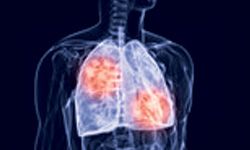BMI May Be a Stratification Factor for Atezolizumab in NSCLC
For patients with non–small cell lung cancer, having a body mass index ≥30 at baseline could be independently associated with an improvement in overall survival with atezolizumab and could be considered a stratification factor in immune checkpoint inhibitor trials, according to a study published in JAMA Oncology.

For patients with nonsmall cell lung cancer (NSCLC), having a body mass index (BMI) ≥30 at baseline could be independently associated with an improvement in overall survival (OS) with atezolizumab (Tecentriq) and could be considered a stratification factor in immune checkpoint inhibitor trials, according to a study published inJAMA Oncology.
“We believe we have identified for the first time that there may be a nearly linear relationship between BMI and OS with atezolizumab therapy when normal, overweight, and obese categories were compared,” the investigators wrote. “The association between BMI and OS remained significant after adjustment for trial-specific stratification factors and several clinically relevant confounders.”
A pooled post hoc analysis of 4 clinical trials of patient-level data identified 2261 patients from NCT02008227 (OAK), NCT01903993 (POPLAR), NCT02031458 (BIRCH), and NCT01846416 (FIR), of which 1434 were evaluable for this study. Among the evaluable patients, 49% were normal weight, 34% were overweight, and 7% were obese. Many of the patients who were obese, compared with the patients who were not obese, were white, male, previous smokers, had a neutrophil to lymphocyte ratio less than 3, and lower C-reactive protein concentrations. Overall, the median age was 64 years (range, 57-70) and 62% were men.
Patients who were considered normal weight, overweight, and obese had significant differences in OS when treated with atezolizumab (P< .001). Patients who were obese and overweight had an improved OS (HR, 0.64; 95% CI, 0.51-0.81 and HR, 0.81; 95% CI, 0.68-0.95; respectively), compared with patients who had a normal BMI.
Additionally, there was a significant difference between PD-L1positive and PD-L1–negative tumors (Pvalue for interaction = .02). Patients considered overweight or obese had a larger survival advantage associated with PD-L1positive tumors (overweight: HR, 0.73; 95% CI, 0.58-0.91 versus obese: HR, 0.48; 95% CI, 0.34-0.66) when compared with PD-L1–negative tumors. Patients who were obese and had high PD-L1 expression (≥50% of tumor cells or ≥10% of tumor-infiltrating immune cells) had an OS hazard ratio of 0.36 (95% CI, 0.21-0.62) and for patients who were overweight, the hazard ratio was 0.69 (95% CI, 0.48-0.98).
The obese and overweight BMI groups of these trials did not have a statistically significant progression-free survival (PFS) when analyzed separately in this analysis (overweight: HR, 0.89; 95% CI, 0.78-1.01 versus obese: HR, 0.86; 95% CI, 0.73-1.01;P= .09) but demonstrated an improved PFS together over patients with a normal BMI (HR, 0.88; 95% CI, 0.78-0.99;P= .03). Although, similar to OS, high PD-L1 expression had the best PFS hazard ratio (obese: HR, 0.68; 95% CI, 0.49-0.94; overweight: HR, 0.72; 95% CI, 0.56-0.92) of the patients with PD-L1positive tumors.
Treatment-related adverse events (TRAEs) did not have significant differences between the BMI groups, with all grade events at 65% for the normal BMI group, 64% for overweight BMI, and 65% for obese BMI (P= .92). Grade 3 through 5 events were 12%, 14%, and 12%, respectively (P= .66).
In patients treated with docetaxel (Taxotere) in the OAK and POPLAR trials, the BMI and OS and PFS had no significant associations, and the OS for PD-L1positive and –negative tumors did not significantly differ between the groups.
OAK, a phase III trial, and POPLAR, a phase II trial, randomized patients with advanced disease who failed prior platinum therapy to 1200 mg of atezolizumab or 75 mg/m2of docetaxel administered intravenously every 3 weeks. BIRCH and FIR were both phase II trials of patients with PD-L1 positive tumors who were receiving atezolizumab as first-line or later lines of treatment. In the pooled analyses of the 4 trials, PD-L1positive tumors were defined as PD-L1 expression on 5% or more of the tumor or tumor-infiltrating cells based on a PDL-1 immunohistochemistry assay from Ventana Medical Systems Inc.
On the first day of trial treatment or study enrollment in 1 of 4 international, multicenter clinical trials of patients with NSCLC, the baseline BMI (weight in kilograms divided by height in meters squared) was calculated and recorded. As categorized by the World Health Organization criteria, BMI was considered underweight at <18.5 kg/m2, normal weight at 18.5 kg/m2to 24.9 kg/m2, overweight at 25 kg/m2to 29.9 kg/m2, and obese at ≥30 kg/m2. If the patient’s height or weight information for the calculation of BMI was missing, or if they fell into the underweight category, they were excluded from the analysis. OS, PFS, and TRAEs were assessed in the intention-to-treat population for the analysis.
The study’s prospective analysis and the investigators emphasized that the results were exploratory and need to be confirmed by future clinical trials. They also pointed out the limitation of BMI as a measurement of obesity because it is unable to differentiate fat from lean muscle mass and unable to diagnose sarcopenia. BMI is also not reflective of body fat distribution.
The analysis used a 1-time recorded height and weight from either screening or day 1 of treatment in the trial to calculate the patients’ BMI, and pretreatment weight loss, which may have variable consequences in treatment response, was variably recorded in the trial’s data set provided. Because of this, the role of any weight loss before or during treatment could not be assessed in the analysis.
Reference:
Kichenadasse G, Miners JO, Mangoni AA, et al. Association between body mass index and overall survival with immune checkpoint inhibitor therapy for advanced nonsmall cell lung cancer.JAMA Oncol.doi: 10.1001/jamaoncol.2019.5241. Published online December 26, 2019. Accessed January 17, 2020.